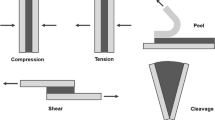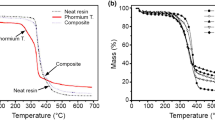Abstract
Curing reaction of polyfurfuryl alcohol (PFA) resin was investigated using rheological measurements in the presence of different acid catalysts. A homologous series of dicarboxylic acid catalysts with even number of carbons of 2, 4 and 6 were chosen, i.e., oxalic acid (OX, 2 carbon), succinic acid (SU, 4 carbon) and adipic acid (AD, 6 carbon). Acidity of these catalysts in terms of pK a was in the range of 1.25–4.43. Firstly, non-isothermal curing kinetics were investigated, and then, isothermal studies were performed at three different temperatures using 3 and 5 wt% of each acid catalyst. Isothermal cure behavior was best described by an empirical Arrhenius model of viscosity. An isoconversional method was applied to compute the changes in the effective activation energy as a function of degree of conversion. The change in activation energy at 50–10 kJ mol−1 was observed for PFA/3 wt% OX system due to the vitrification and diffusion-controlled processes. Gel time, t gel, was determined as a function of curing temperature, acid catalyst type and its concentration. The gelation time was consistent for all the formulations with an extent of conversion of about 0.7. Significant differences were observed in the curing behavior of resins in the presence of different acid catalysts. Increasing of the curing temperature significantly accelerated the curing process and increased curing rate constant of the PFA resin.











Similar content being viewed by others
References
Deka H, Misra M, Mohanty A (2013) Renewable resource based ‘all green composites’ from kenaf biofiber and poly (furfuryl alcohol) bioresin. Ind Crops Prod 41:94–101
Guigo N, Mija A, Vincent L, Sbirrazzuoli N (2010) Eco-friendly composite resins based on renewable biomass resources: polyfurfuryl alcohol/lignin thermosets. Eur Polym J 46:1016–1023
Domínguez JC, Grivel JC, Madsen B (2012) Study on the non-isothermal curing kinetics of a polyfurfuryl alcohol bioresin by DSC using different amounts of catalyst. Thermochim Acta 529:29–35
Schmitt CR (1974) Polyfurfuryl alcohol resin. Polym Plast Technol Eng 3:121–158
Bertarione S, Bonino F, Cesano F, Damin A, Scarano D, Zecchina A (2008) Micro-FTIR and micro-Raman studies of a carbon film prepared from furfuryl alcohol polymerization. J Phys Chem B 113:10571–10574
Choura M, Belgacem NM, Gandini A (1996) Acid-catalyzed polycondensation of furfuryl alcohol: mechanisms of chromophore formation and cross-linking. Macromolecules 29:3839–3850
Zavaglia R, Guigo N, Sbirrazzuoli N, Mija A, Vincent L (2012) Complex kinetic pathway of furfuryl alcohol polymerization catalyzed by green montmorillonite clays. J Phys Chem B 116:8259–8268
Lange J, Altmann N, Kelly CT, Halley PJ (2000) Understanding vitrification during cure of epoxy resins using dynamic scanning calorimetry and rheological techniques. Polymer 41:5949–5955
Rivero G, Pettarin V, Vázquez A, Manfredi LB (2011) Curing kinetics of a furan resin and its nanocomposites. Thermochim Acta 516:79–87
Carotenuto G, Nicolais L (1999) Kinetic study of phenolic resin cure by IR spectroscopy. J Appl Polym Sci 74:2703–2715
Persson S, Goude M, Olsson T (2003) Studying the cure kinetics of rubber-to-metal bonding agents using DMTA. Polym Test 22:671–676
Marzocca AJ, Garraza ALR, Sorichetti P, Mosca HO (2010) Cure kinetics and swelling behaviour in polybutadiene rubber. Polym Test 29:477–482
Guigo N, Mija A, Vincent L, Sbirrazzuoli N (2007) Chemorheological analysis and model-free kinetics of acid catalysed furfuryl alcohol polymerization. Phys Chem Chem Phys 9:5359–5366
Kulichikhin SG, Voit VB, Malkin AY (1996) Rheokinetics of urea-formaldehyde resins gelation. Rheol Acta 35:95–99
Hu J, Yuan P, Zeng K, Yang G (2014) Study of the curing kinetics of a benzimidazole/phthalonitrile resin system. Thermochim Acta 590:30–39
Wisanrakkit G, Gillham JK (1990) The glass transition temperature (T g) as an index of chemical conversion for a high-T g amine/epoxy system: chemical and diffusion-controlled reaction kinetics. J Appl Polym Sci 41:2885–2929
Hwang JG, Row CG, Hwang I, Lee SJ (1994) A chemorheological study on the curing of thermosetting resins. Ind Eng Chem Res 33:2377–2383
Peng W, Riedl B (1994) The chemorheology of phenol-formaldehyde thermoset resin and mixtures of the resin with lignin fillers. Polymer 35:1280–1286
Mravljak M, Sernek M (2011) The influence of curing temperature on rheological properties of epoxy adhesives. Drvna Ind 62:19–25
Auad ML, Nutt SR, Stefani PM, Aranguren MI (2006) Rheological study of the curing kinetics of epoxy–phenol novolac resin. J Appl Polym Sci 102:4430–4439
Domínguez JC, Madsen B (2014) Chemorheological study of a polyfurfuryl alcohol resin system—pre-gel curing stage. Ind Crop Prod 52:321–328
Wewerka EM, Loughran ED, Walters KL (1971) A study of the low molecular weight components of furfuryl alcohol polymers. J Appl Polym Sci 15:1437–1451
Marefat Seyedlar R, Imani M, Mirabedini SM (2016) Curing of poly (furfuryl alcohol) resin catalyzed by a homologous series of dicarboxylic acid catalysts: kinetics and pot life. J Appl Polym Sci 133:1–11
Ammar M, Khiari R, Belgacem MN, Elaloui E (2015) Gelation and isoconversional kinetic analysis of synthesis of lignin–resorcinol–glyoxal resin curing. Iran Polym J 24:919–925
Poorabdollah M, Beheshty MH (2013) Effect of resin composition on curing kinetic of nanoclay-reinforced unsaturated polyester resins. Iran Polym J 22:385–398
Sun L (2001) Thermal rheological analysis of cure process of epoxy prepreg. Ph.D. Thesis, Louisiana State University, Baton Rouge
Prime RB (1997) In: Turi EA (ed) Thermal characterization of polymeric materials, 2nd edn. Academic, New York
Sun G, Sun H, Liu Y, Zhao B, Zhu N, Hu K (2007) Comparative study on the curing kinetics and mechanism of a lignin-based-epoxy/anhydride resin system. Polymer 48:330–337
Dimier F, Sbirrazzuoli N, Vergnes B, Vincent M (2004) Curing kinetics and chemorheological analysis of polyurethane formation. Polym Eng Sci 44:518–527
Hu J, Shan J, Zhao J, Tong Z (2016) Isothermal curing kinetics of a flame retardant epoxy resin containing DOPO investigated by DSC and rheology. Thermochim Acta 632:56–63
Romasanta LJ, Lopez-Manchado MA, Verdejo R (2013) The role of carbon nanotubes in both physical and chemical liquid–solid transition of polydimethylsiloxane. Eur Polym J 49:1373–1380
Lucio B, de la Fuente JL (2016) Non-isothermal DSC and rheological curing of ferrocene-functionalized, hydroxyl-terminated polybutadiene polyurethane. React Funct Polym 107:60–68
Cañamero PF, de la Fuente JL, Fernández-García M (2009) Curing kinetic study using a well-controlled multifunctional copolymer based on glycidyl methacrylate. Eur Polym J 45:2665–2673
Lucio B, de la Fuente JL (2014) Rheological cure characterization of an advanced functional polyurethane. Thermochim Acta 596:6–13
Seidel C, Kulicke WM, Heß C, Hartmann B, Lechner MD, Lazik W (2001) Influence of the cross-linking agent on the gel structure of starch derivatives. Starch Stärke 53:305–310
Marefat Seyedlar R, Nodehi A, Atai M, Imani M (2014) Gelation behavior of in situ forming gels based on HPMC and biphasic calcium phosphate nanoparticles. Carbohydr Polym 99:257–263
Tung CYM, Dynes PJ (1982) Relationship between viscoelastic properties and gelation in thermosetting systems. J Appl Polym Sci 27:569–574
Guigo N (2008) Biomass based materials: polymers, composites and nano-hybrids from furfuryl alcohol and lignin. Doctoral dissertation, École Doctorale Sciences Fondamentales et Aappliquées (Nice)
Cañamero-Martínez P, Fernandez-Garcia M, la Fuente JL (2010) Rheological cure characterization of a polyfunctional epoxy acrylic resin. React Funct Polym 70:761–766
Sbirrazzuoli N, Vyazovkin S, Mititelu A, Sladic C, Vincent L (2003) A study of epoxy-amine cure kinetics by combining isoconversional analysis with temperature modulated DSC and dynamic rheometry. Macromol Chem Phys 204:1815–1821
Vyazovkin S, Sbirrazzuoli N (1996) Mechanism and kinetics of epoxy-amine cure studied by differential scanning calorimetry. Macromolecules 29:1867–1873
Acknowledgements
This research is funded by Iran Polymer and Petrochemical Institute (Grant No. 32751105). The authors are sincerely thankful for this financial support.
Author information
Authors and Affiliations
Corresponding author
Rights and permissions
About this article
Cite this article
Marefat Seyedlar, R., Imani, M. & Mirabedini, S.M. Rheokinetics in curing process of polyfurfuryl alcohol: effect of homologous acid catalysts. Iran Polym J 26, 281–293 (2017). https://doi.org/10.1007/s13726-017-0518-0
Received:
Accepted:
Published:
Issue Date:
DOI: https://doi.org/10.1007/s13726-017-0518-0




